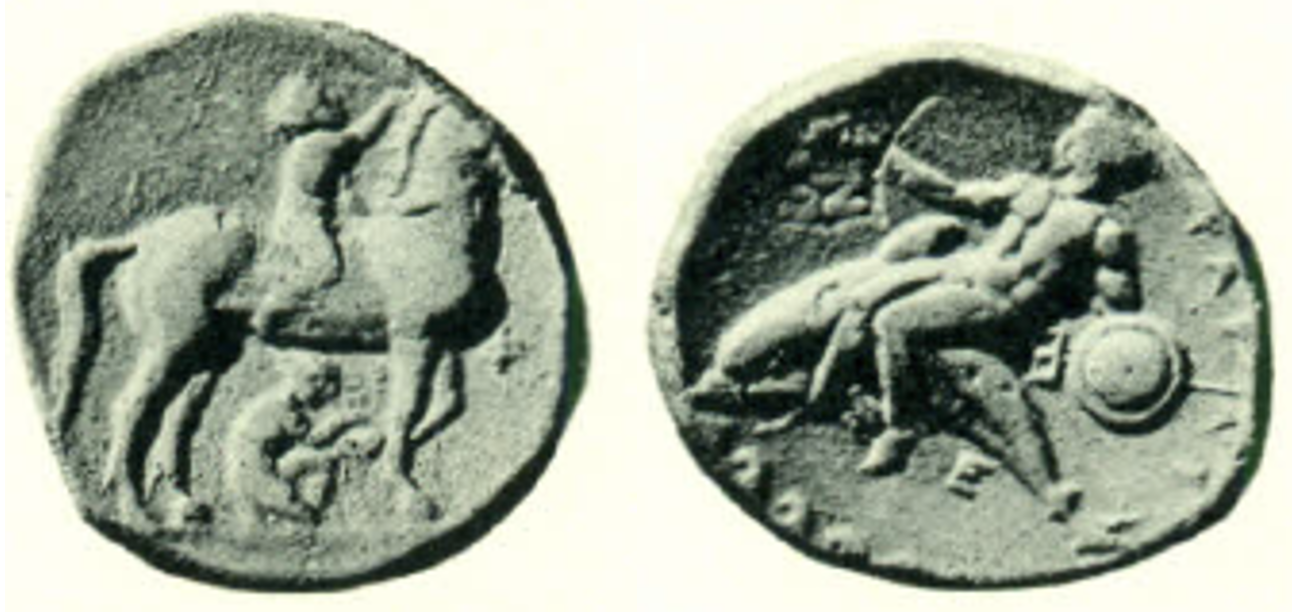Revision as of 06:04, 17 January 2024
340 BCE - 332 BCE | TAPAΣ
Overstriking coin
SO 1301 - Taras over Ambracia.png
Description
| ObverseInscription or printing placed on the obverse.:
|
Youth seated on a horse right, crowning horse raisong foot for crouching youth to remove stone. In right field, φ.
|
ReverseInscription or printing placed on the reverse.:
|
TAPAΣ (Greek) Male character (Taras or Phalanthos), nude, seated on a dolphin to left, holding cantharos, trident and shield. Below, E and wave pattern.
|
Mint and issuing power
| MintIdentifies the place of manufacture or issue of a numismatic object.:
|
Taras
|
Ancient regionAncient region.
|
Magna Graecia (Calabria)
|
Modern countryModern country: Italy
|
AuthorityIdentifies the issuing power. The authority can be "pretended" when the name or the portrait of X is on the coin but he/she was not the issuing power. It can also be "uncertain" when there is no mention of X on the coin but he/she was the issuing power according to the historical sources:
|
|
Chronology
| FromIdentifies the initial date in a range assigned in a numismatic context. 340 BCE toIdentifies the final date in a range assigned in a numismatic context.. 332 BCE
|
Classical 480-323 BC  periodTime period of the numismatic object. periodTime period of the numismatic object.
|
Physical description
MetalThe physical material (usually metal) from which an object is made.: Silver 
|
|
DenominationTerm indicating the value of a numismatic object. Examples: tetradrachm, chalkous, denarius.: tridrachm / nomos
|
|
|
|
StandardStandard.: Achaian
|
References
Description
| ObverseInscription or printing placed on the obverse.:
|
Pegasus
|
ReverseInscription or printing placed on the reverse.:
|
Head of Athena.
|
Mint and issuing power
| MintIdentifies the place of manufacture or issue of a numismatic object. ᵖ:
|
Ambracia
|
Ancient regionAncient region. ᵖ
|
Epirus
|
Modern countryModern country: Greece
|
AuthorityIdentifies the authority in whose name (explicitly or implicitly) a numismatic object was issued. ᵖ:
|
|
Chronology
| FromIdentifies the initial date in a range assigned in a numismatic context. toIdentifies the final date in a range assigned in a numismatic context..
|
periodTime period of the numismatic object.
|
Physical description
References
References
- ^ Rutter N. Keith et alii (eds.) (2001), Historia Numorum Italy, London, xvi, 223 p., 43 pl.
- ^ Hoover, Oliver D. (2018), The Handbook of Greek Coinage Series, Volume 1. Handbook of Coins of Italy and Magna Graecia, Sixth to First Centuries BC., Lancaster-London, 2018, lxi, 527 pages, 23 cm
